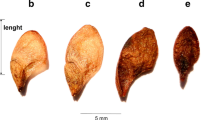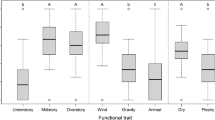Summary
Using the subcanopy tree Faramea occidentalis in Panama, I studied post-dispersal seed survival as a function of five characteristics describing seed locations. By simultaneously considering distance from a conspecific adult, size of the nearest conspecific adult, leaf litter quantity, proximity to logs or tree trunks, and whether or not the seed was in a gap, I was able to analyze the influences of individual factors, as well as the interactions among factors. Seed survival was significantly less in treefall gaps than in the forest understory. Seed survival was also influenced by the size of the nearest adult but in a complex interaction with distance to an adult. For seeds beneath adults, survival decreased with increasing tree size, while for seeds away from adults, survival was independent of the size of the nearest conspecific adult. Distance did not directly affect seed survival, nor did the quantity of leaf litter or the proximity to a tree trunk or a log. In a separate analysis, the relationship between distance and seed survival was consistent over four years, suggesting that single cohort studies may provide accurate insights into the consequences of dispersal. In contrast, the spatial locations of surviving seeds were not consistent over the four-year period. Transects with high survival one year did not tend to have high survival in other years, and the locations of surviving seeds in any particular year could not be predicted from the knowledge of where seeds survived in other years. While survival is patchy within a year, the locations of patches shift from year to year.
Similar content being viewed by others
References
Croat TB (1978) Flora of Barro Colorado Island. Stanford University Press, Stanford
Emmons LH (1982) Ecology of Proechimys (Rodentia, Echimyidae) in southeastern Peru. Trop Ecol 23:280–290
Foster, RB (1982) The seasonal rhythm of fruitfall on Barro Colorado Island. In: Leigh EG Jr, Rand AS, Windsor DM (eds) The ecology of a tropical forest. Seasonal rhythms and long-term changes. Smithsonian Institution Press, Washington, DC, pp 151–172
Gardner G, (1977) The reproductive capacity of Fraxinus excelsior on the derbyshire limestone. J Ecol 65:107–118
Gashwiler JS (1967) Conifer seed survival in a western Oregon clearcut. Ecology, 48:431–438
Howe HF, Schupp EW, Westley, LC (1985) Early consequences of seed dispersal for a neotropical tree (Virola surinamensis). Ecology 66:781–791
Hubbell SP (1980) Seed predation and the coexistence of tree species in tropical forests. Oikos 35:214–229
Hubbell SP, Foster RB (1983) Disversity of canopy trees in a neotropical forest and its implications for conservation. In: Sutton SL, Whitmore TC, Chadwick AC (eds) Tropical rain forest: ecology and management. Special Publication Number 2 of the British Ecological Society. Blackwell Scientific Publications, Oxford, pp 25–41
Janzen DH (1970) Herbivores and the number of tree species in tropical forests. Am Nat 104:501–529
Janzen DH (1971) Seed predation by animals. Annu Rev Ecol Syst 2:465–492
Janzen DH (1983) Seed and pollen dispersal by animals: convergence in the ecology of contamination and sloppy harvest. Biol J Linn Soc 20:103–113
Janzen DH, Miller GA, Hackforth-Jones J, Pond CM, Hooper K, Janos DP (1976) Two Costa Rican bat-generated seed shadows of Andira inermis (Leguminosae). Ecology 57:1068–1075
Kiltie RA (1981) Distribution of palm fruits on a rain forest floor: why white-lipped peccaries forage near objects. Biotropica 13:141–145
Leigh EG Jr, Rand AS, Windsor DM (eds) (1982) The ecology of a tropical forest. Seasonal rhythms and long-term changes. Smithsonian Institution Press, Washington, DC
Muenchow G (1986) Ecological use of failure time analysis. Ecology 67:246–250
Nilsson SG, Wästljung U (1987) Seed predation and cross-pollination in mast-seeding beech (Fagus sylvatica) patches. Ecology 68:260–265
Pyke DA, Thompson JN (1986) Statistical analysis of survival and removal rate experiments. Ecology 67:240–245
Ramírez N, Arroyo MK (1987) Variacion espacial y temporal en la depredacion de semillas de Copaifera pubiflora Benth. (Leguminosae: Caesalpinioideae) en Venezuela. Biotropica 19:32–39
Rand AS, Rand WM (1982) Variation in rainfall on Barro Colorado Island. In: Leigh EG Jr, Rand AS, Windsor DM (eds) The ecology of a tropical forest. Seasonal rhythms and long-term changes. Smithsonian Institution Press, Washington, DC, pp 47–59
Rood JP, Test FH (1968) Ecology of the spiny rat, Heteromys anomalus, at Rancho Grande, Venezuela. Am Midl Nat 79:89–102
SAS Institute Inc (1985) SAS user's guide: statistics, version 5 edition. SAS Institute Inc, Cary
Schupp EW (1987) Studies on seed predation of Faramea occidentalis, an abundant tropical tree. Dissertation, Univ Iowa, Iowa City
Schupp EW (1988) Seed and early seedling predation in the forest understory and in treefall gaps. Oikos 51:71–78
Schupp EW, Howe HF, Augspurger CK, Levey DJ (1988) Arrival and survival in tropical treefall gaps. Ecology 69: (in press)
Shaw MW (1968) Factors affecting the natural regeneration of sessile oak (Quercus petraea) in North Wales I. A preliminary study of acorn production, viability and losses. J Ecol 56:565–583
Smith AJ (1975) Invasion and ecesis of bird-disseminated woody plants in a temperate forest sere. Ecology 56:19–34
Smythe N (1970) Relationships between fruiting seasons and seed dispersal methods in a neotropical forest. Am Nat 104:25–35
Smythe N (1986) Competition and resource partitioning in the guild of neotropical terrestrial frugivorous mammals. Annu Rev Ecol Syst 17:168–188
Smythe N, Glanz WE, Leigh EG Jr (1982) Population regulation in some terrestrial frugivores. In: Leigh EG Jr, Rand AS, Windsor DM (eds) The ecology of a tropical forest. Seasonal rhythms and long-term changes. Smithsonian Institution Press, Washington, DC, pp 227–238
Sork VL, Stacey P, Averett JE (1983) Utilization of red oak acorns in a non-bumper crop year. Oecologia (Berlin) 59:49–53
Webb SL, Willson MF (1985) Spatial hetereogeneity in post-dispersal predation in Prunus and Uvularia seeds. Oecologia (Berlin) 67:150–153
Wheelwright NT, Orians GH (1982) Seed dispersal by animals: contrasts with pollen dispersal, problems of terminology, and constraints on coevolution. Am Nat 119:402–413
Wilkinson L (1986) SYSTAT: the system for statistics. SYSTAT, Inc., Evanston
Willson MF (1988) Spatial heterogeneity of post-dispersal survivorship of Queensland rainforest seeds. Aust J Ecol (in press)
Wright SJ (1983) The dispersion of eggs by a bruchid beetle among Scheelea palm seeds and the effect of distance to the parent. Ecology 64:1016–1021
Author information
Authors and Affiliations
Rights and permissions
About this article
Cite this article
Schupp, E.W. Factors affecting post-dispersal seed survival in a tropical forest. Oecologia 76, 525–530 (1988). https://doi.org/10.1007/BF00397864
Received:
Issue Date:
DOI: https://doi.org/10.1007/BF00397864




